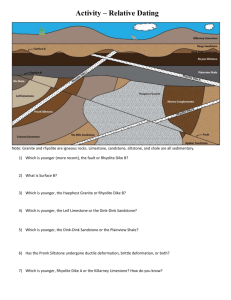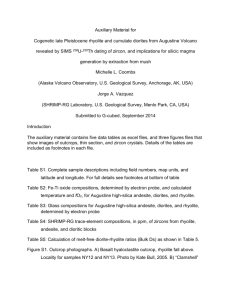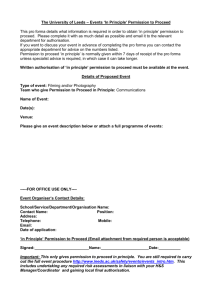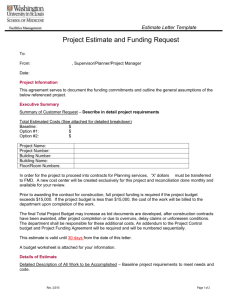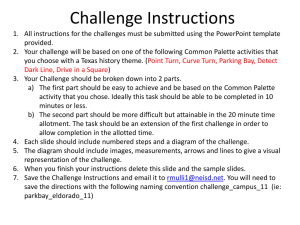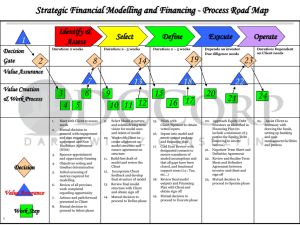Field Trip to St. Francois Mts. Missouri Geology Stops & Logistics
advertisement
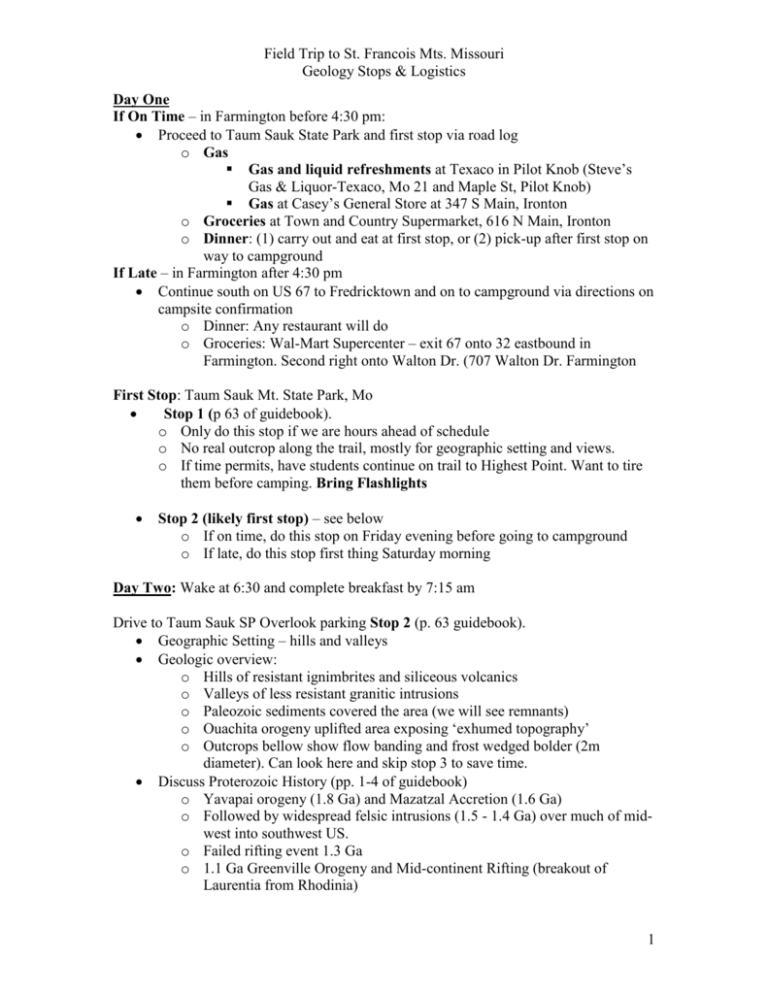
Field Trip to St. Francois Mts. Missouri Geology Stops & Logistics Day One If On Time – in Farmington before 4:30 pm: Proceed to Taum Sauk State Park and first stop via road log o Gas Gas and liquid refreshments at Texaco in Pilot Knob (Steve’s Gas & Liquor-Texaco, Mo 21 and Maple St, Pilot Knob) Gas at Casey’s General Store at 347 S Main, Ironton o Groceries at Town and Country Supermarket, 616 N Main, Ironton o Dinner: (1) carry out and eat at first stop, or (2) pick-up after first stop on way to campground If Late – in Farmington after 4:30 pm Continue south on US 67 to Fredricktown and on to campground via directions on campsite confirmation o Dinner: Any restaurant will do o Groceries: Wal-Mart Supercenter – exit 67 onto 32 eastbound in Farmington. Second right onto Walton Dr. (707 Walton Dr. Farmington First Stop: Taum Sauk Mt. State Park, Mo Stop 1 (p 63 of guidebook). o Only do this stop if we are hours ahead of schedule o No real outcrop along the trail, mostly for geographic setting and views. o If time permits, have students continue on trail to Highest Point. Want to tire them before camping. Bring Flashlights Stop 2 (likely first stop) – see below o If on time, do this stop on Friday evening before going to campground o If late, do this stop first thing Saturday morning Day Two: Wake at 6:30 and complete breakfast by 7:15 am Drive to Taum Sauk SP Overlook parking Stop 2 (p. 63 guidebook). Geographic Setting – hills and valleys Geologic overview: o Hills of resistant ignimbrites and siliceous volcanics o Valleys of less resistant granitic intrusions o Paleozoic sediments covered the area (we will see remnants) o Ouachita orogeny uplifted area exposing ‘exhumed topography’ o Outcrops bellow show flow banding and frost wedged bolder (2m diameter). Can look here and skip stop 3 to save time. Discuss Proterozoic History (pp. 1-4 of guidebook) o Yavapai orogeny (1.8 Ga) and Mazatzal Accretion (1.6 Ga) o Followed by widespread felsic intrusions (1.5 - 1.4 Ga) over much of midwest into southwest US. o Failed rifting event 1.3 Ga o 1.1 Ga Greenville Orogeny and Mid-continent Rifting (breakout of Laurentia from Rhodinia) 1 Field Trip to St. Francois Mts. Missouri Geology Stops & Logistics Stop 2 continued Discuss Early Paleozoic History o Passive margin platform deposits on Laurentian shelf (Cambrian through Ordovician) o Applachian orogenic (Taconic, Acadian, Alleganian and Ouchita) events close Iapetus Ocean and form Pangaea o Ouachita uplifts Missouri exposing lower Paleozoic and upper Proterozoic Return to vehicle and proceed ~1.5 mi east on Mo CC to Stop 3 You can skip this stop – all is done at Stop 2 Royal Gorge Rhyolite – Flow banding Discuss flow banding, magma viscosity silica and gas content Flow is not explosive, thus low gas content Return to vehicles and proceed east to intersection with Mo 21. Turn north/left and proceed to Stop 4b on MO 21 north of Ironton and Pilot Knob Welded Tuff (ignimbrite) with excellent Fiamme Discuss explosive eruption – Nuee Ardente Setting – similar to Yellowstone (hotspot) or convergent margin with back-arc basin Return to vehicles and proceed south on rte 21 past Arcadia to road cut just south of 2172 interchange Stop 4a on Mo 21/72 south of Arcadia Outcrop has two ingnimbrite flows dipping S Flows are separated by a flow breccia Base of flows are to the North Fiame at the base, grade to massive, then brecciated at the top Return to vehicles, turn around and proceed north on Mo 21 to Elephant Rocks S.P. for lunch and Stop 5: Elephant Rocks State Park (Altaner Stop 7, guidebook p. 42) Rock collecting is prohibited in park: leave hammers in vehicles. Depending on time of arrival: Lunch then see the park or vise versa. If too early for lunch, put it off ‘till next Stop. Meet at top/high point of park to discuss… o Musc-Biot, alkali granite (55% alkali feld, 40% quartz, <5% mafics) o Discuss Boulders: contraction/cooling fractures, then expansion jointing during uplift produces blocks that then undergo spheroidal weathering. Proceed through ‘fatman’s squeeze’ toward old quarry o Discuss intrusive relationships observed in walls of quarry (?) o Discuss quarry of granite – paved St. Louis, now ornamental stone from W to E coast. 2 Field Trip to St. Francois Mts. Missouri Geology Stops & Logistics Return to Vehicles and proceed north on Mo 21 (right out of Elephant Rocks) for ~13 miles to Mo M. East (right) on M for ~3.4 miles to County Road 541. South (right) on Co. Rd. 541 and go ~0.3 mi to crest of hill. Park in the Hughes Mt. Natural Area lot on east (left) side of road. Stop 6 Hughes Mountain Natural Area Hike ~0.75 miles up trail to opening Discuss Columnar Jointing Evidence for flow, not explosive, eruption – recap evidences we’ve seen for both types of eruption Return to Vehicles and proceed north on 541 to intersection with M. Turn right/east on M and proceed ~2.5 mi to Mo U. Turn right/south on U and go ~5 miles to Mo 32 in Bismark. Turn left/east on 32 and go ~4.5 mi toward Derby Junction. At the intersection, perform a U-Turn, very carefully, and proceed back west on 32 for ~1.6 miles toward Bismark. Stop 7: Road-cut on MO 32, 2.9 mi north of Bismark. Rhyilite with Precambrian paleosol and Regolith overlain by Lamotte Sand Stone Pull off near road cut and be very careful! Precambrian Rhyolite with Precambrian paleosol/regolith/C-horizon Paleosol is bleached white, porphyritic rhyolite Exposure of Lamotte SS on East end of outcrop (galena crystals too) – alluvial/fluvial Find teaching sample of breccia containing regolith fragment (rare in outcrop) proving timing of breccia. Stop 7b: Road-cuts south of stop 7 on MO 32 – Are these dolomite or SS? If time permits: Choose between two possible additional stops (or do both). Weather may dictate stops and/or routes. I liked Alternate 8a and 8b Stop 8: Preferred Stop (I think). This involves taking county roads that may be muddy if raining (access to overlook is mix of gravel and dirt non-4x4 may have trouble if wet). Stop 8b may be preferred stop b/c it offers new feature – ‘thunder eggs’. Stop 8 offers view of Sabula basin and St. Francois Mountains. Good location for a recap of the day’s geology. Outcrops of trachyte porphyry with xenoliths and flow breccia. From Stop 7, Proceed west on MO 32 to Bismark and turn left/south on SR N toward Iron Mountain. Go right/west at three-way intersection with SR W continuing toward Iron Mountain and on to MO 21. Turn left/south on MO 21 and proceed through Ironton and Arcadia. After Arcadia take a left/south on SR E. Turn right/southwest on CR 131 (unmarked road, but mail boxes are addressed) and stay on CR131 for ~3.2 miles and 3 Field Trip to St. Francois Mts. Missouri Geology Stops & Logistics turn left/east on unmarked gravel road before CR131C. Continue ~0.9 mi up the mountain toward Crane Mountain Lookout. Park in the clearing near the summit. Walk ~ 50’ W, downhill form the summit to outcrops on SW flank of mountain. Stop 8: Outcrops are on the SW side of the mountain. Rocks are Precambrian Trachyte Porphyry o Phenocrysts: Na-plag and orthoclase (Na-feld) o Holocrystalline groundmass showing trachytic texture (alignment of plag laths from flow), with abundant magnetite grains in groundmass. Near the top of the outcrops, the trachyte contains twisted and contorted xenoliths. o These are conspicuous, dark inclusions ranging from a few inches to feet in diameter, with sharp contacts. o Polished surfaces show relict layering and thin sections confirm this is recrystallized vitric-tuff that was entrained in the trachyte flow. Sabula Basin: is a normal-fault-bounded basin filled with Cambrian Sediments. The orientation of the basin is parallel to major regional lineaments that dissect the mountains. Return to vehicles and retrace route to CR E. Turn left/north on CR E and head toward Ironton. At intersection with MO 21, turn left/west toward Taum Sauk SP. Right/north on CR CC into the park and camp. Alternate Stop 8A and B: If weather is bad, or there is barely time for a stop (this one is off of better roads compared to Stop 8). This alternate stop offers Lithophysal Rhyolite and Fiamme. If there has been a lot of rain, take alternate rout to Alternate Stop 8, possibly skipping Alternate Stop 8A depending on time. From Stop 7, proceed as for Stop 8 to Arcadia and continue south of Arcadia on MO 21/72 toward Hogan. In Hogan, go right/west on SR AA for approximately 2 miles. Alternate Stop 8A: Outcrops/road cuts on northeast side of AA are of Taum Sauk Rhyolite, showing excellent Fiamme – some as large as a meter. (Page 71 of guidebook). Continue northwest on SR AA and turn left/southwest on CR 204. Proceed on CR 204 toward the lower reservoir and park at the Lower Reservoir scenic overlook on the right/north side of the road. The lower reservoir dam should be visible ~500 feet north of the road. 4 Field Trip to St. Francois Mts. Missouri Geology Stops & Logistics Alternate Stop 8B: Road cuts on south side of CR 204 opposite the overlook parking expose Bell Mountain Rhyolite. Lithophysal (‘thunder-eggs’) Rhyolite Well exposed ~325’ east/uphill from the overlook on the south side of the road. Lithosphyae are up to 2” in diameter o Commonly filled with vapor-phase quartz and fluorite Rhyolite is a crystal-poor tuff composed of compacted, devitrified glass shards. Some ‘rip-up’ clasts within the unit indicated fragmented nature of flow and emplacement. Alternate route to Alternate Stop 8B (if by chance rivers are high): Proceed on MO 21/72 south through Hogan. Approximately 1 mi south of Hogan, turn right/west on MO 21/72/49 and proceed west ~7 to 10 miles to SR U. Turn right/north on SR U and proceed to Lower Reservoir scenic overlook. After Alternate Stop 8 retrace route to MO 21/72 and head north toward Taum Sauk SP and Ironton. Turn left/west on CR CC and head to Taum Sauk SP and camp. Day Three Wake at 6:30 and complete breakfast by 7:15 am. Pack-up camp and be on the road by 9:15. Depart Taum Sauk Mtn SP on CR CC to intersection with MO 21/72. Turn right/north on 21/72 toward Arcadia. In Arcadia turn right/east on MO 72 toward Roselle and Fredericktown. Proceed 13.5 miles to CR D in Oak Grove. Turn right/south on CR D toward Silver Mines Rec. Area (single story brick house is at the corner with D). Proceed ~3.1 miles to Silver Mines Rec Area. Turn right/north into park and proceed to park. Exit cars have TA pay for parking ($2 per car) Cross road follow trail on northeast side of river (?) heading upstream toward the Sivermine dam. Follow trail down to river exposure just before the Silvermine dam. 5 Field Trip to St. Francois Mts. Missouri Geology Stops & Logistics Stop 9: Riverside exposure of mafic dike cutting Silvermine granite. Dike = 1.35 Ga diabasic basalt/gabbro. o Dike shows crystal size variation due to cooling near margins, and columnar jointing. o Blocks in the dam have xenocrysts of K-spar and qts from granite Silvermine Granite = 1.47 Ga Medium grained amphibole-biotite-granite composed of 40% orthoclase, 30% albite, 20% quartz, 10% mafics. Granite contains xenoliths of intermediate composition. Mines in the area operated from 1877-1894 (silver from galena in qtz veins) and 19161946 (tungsten). Pneumatolytic in origin (from gas phase). Return to vehicles and proceed out of park. Turn left/northeast on D toward Oak Grove. Proceed ~3.1 mi to junction with Mo 72. Turn right/east on Mo 72 and proceed ~2.6 miles. Pull off at road-cut/outcrop on right side of road. SAFETY Stop 10: Road-cut 3.5 miles west of Fredericktown on Mo 72. Basaltic dike intruding rhyolite unconformably overlain Paleozoic sediments. Want students to Sketch outcrop to scale, and work out timing of events. Basaltic Dike: ~4’ thick, 1.2 Ga, Diabasic Texture. o Note difference between exposures on N and S road-cuts. N side is missing Paleozoic exposure. o Easily weathered compared to rhyolite Rhyolite: Porphyritic o Grassy Mountain Ignimbrite – from Butler Hill caldera Paleozoic Sediments o Basal conglomerate of Lamotte Sandstone deposited on Precambrian rocks Alluvial and Fluvial seds. o Bonneterre Dolomite (not at this outcrop). Return to vehicles and proceed 1.8 miles east on Mo 72 toward Fredericktown and intersection with US 67. Turn left/north on US 67 toward St. Louis. Proceed on US 67 for 7.5 miles to access road to Knob Lick Lookout Tower. Note: the access road is marked with a brown sign, and is immediately after the Family Theater Bldg. Make a left turn across oncoming traffic and then an immediate right onto gravel road heading up Knob Lick. Proceed up hill to the lookout tower and park. Exit vehicles and walk north along trail past the tower. Continue on trail for 450 paces to stand pipe, then 200 paces to turnoff. Turn right and enter small, low, brush-covered quarry. 6 Field Trip to St. Francois Mts. Missouri Geology Stops & Logistics Stop 11: Knoblick Mountain Quarry 1.5 miles west of Knoblick: Knoblick Granite intruding Grassy Mountain Ignimbrite (rhyolite). Intrusive contact in sharp and undulating with common epidote veins o Rhyolite above contact is thermally metamorphosed to quartz, felspar hornfels. Stoped block of rhyolite within granite Review Geology seen on the trip: Rocks o Oldest = volcanics (Grassy Mountain Ignimbrite) Ignimbrites and flows. Likely Caldera Colapse Form hills today o Granitic Intrusives penicontemporaneous with volcanics Silvermine and Knoblick granites with Grassy Mountain Ignimbrite (older unit = Butler Hill Group) Graniteville Granite (Elaphant Rocks) with Taum Sauk and Johnson Shut-ins and Royal Gorge Rhyolites (younger unit = Taum Sauk Group). o Mafic Basalts 1.3 Ga rifting event o Marine Sediments Lamotte Sandstone Bonneterra Dolomite Structures and interpretations o Fiamme = compaction of pumice under weight. Pumice = explosive Welded tuff = hot while compacting All together = ignimbrite (huge explosive, viscous, nuee ardent). o Columnar jointing = cooling of flow or dike o Dikes = intrusion under tension o Intrusive and cross-cutting relationships indicate sequences (below) Dikes cut rhyolites Dikes truncated by Paleozoics Regolith in Precambrian units (dikes too) Rhyolite stoped in granite Event sequences o Rhyolite explosive eruption and flow o Granitic intrusion and stoping of rhyolite o Basaltic dike intrusions o Uplift and Exposure of igneous terrain o Transgression of Cambrian Sea and deposition of Paleozoic sediments on islands of rhyolite o Ouachita orogeny uplifts region exposing it. 7
